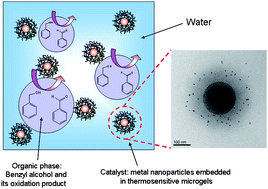Thermosensitive core-shell microgel as a “nanoreactor” for catalytic active metal nanoparticles
Abstract
Thermosensitive core-shell microgels can be used as “nanoreactors” for the immobilization of metal

* Corresponding authors
a
Institute of Physical Chemistry I, University of Bayreuth, Bayreuth, Germany
E-mail:
Yan.Lu@uni-bayreuth.de
Fax: +49-921-552780
b Institute of Inorganic Chemistry II, University of Bayreuth, Bayreuth, Germany
c Institute of Macromolecular Chemistry II, University of Bayreuth, Bayreuth, Germany
Thermosensitive core-shell microgels can be used as “nanoreactors” for the immobilization of metal

 Please wait while we load your content...
Something went wrong. Try again?
Please wait while we load your content...
Something went wrong. Try again?
Y. Lu, S. Proch, M. Schrinner, M. Drechsler, R. Kempe and M. Ballauff, J. Mater. Chem., 2009, 19, 3955 DOI: 10.1039/B822673N
To request permission to reproduce material from this article, please go to the Copyright Clearance Center request page.
If you are an author contributing to an RSC publication, you do not need to request permission provided correct acknowledgement is given.
If you are the author of this article, you do not need to request permission to reproduce figures and diagrams provided correct acknowledgement is given. If you want to reproduce the whole article in a third-party publication (excluding your thesis/dissertation for which permission is not required) please go to the Copyright Clearance Center request page.
Read more about how to correctly acknowledge RSC content.
 Fetching data from CrossRef.
Fetching data from CrossRef.
This may take some time to load.
Loading related content
